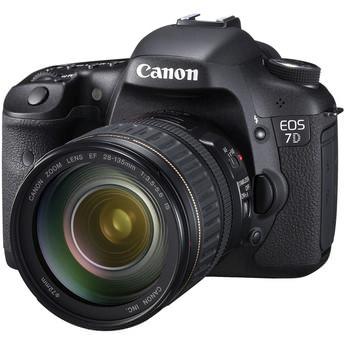 There is little doubt that Canon’s strategy behind the EOS 7D was to regain the company’s prominence among cameras with APS-C sensors. That king-of-the-hill position had been firmly established with Canon’s X0D line of cameras (10D, 20D and 30D); however, competition from such cameras, as Sony's A700 and Nikon's D200 and 300, has contributed to this slight loss of status of Canon’s X0D series. Serious digital photography enthusiasts, would-be professionals and professionals are primarily responsible for the success and popularity of X0D cameras. These photographers are able to obtain superior image quality and photographic capabilities, but at a price and a size significantly less than a true professional DSLR, such as the 1D series.
There is little doubt that Canon’s strategy behind the EOS 7D was to regain the company’s prominence among cameras with APS-C sensors. That king-of-the-hill position had been firmly established with Canon’s X0D line of cameras (10D, 20D and 30D); however, competition from such cameras, as Sony's A700 and Nikon's D200 and 300, has contributed to this slight loss of status of Canon’s X0D series. Serious digital photography enthusiasts, would-be professionals and professionals are primarily responsible for the success and popularity of X0D cameras. These photographers are able to obtain superior image quality and photographic capabilities, but at a price and a size significantly less than a true professional DSLR, such as the 1D series.
Read real customer reviews of the Canon EOS 7D DSLR here.
It’s clearly evident that the 7D is closely related to the EOS 50D, but it is much more than a simple upgrade, which may be signified by the fact it is called the 7D, and not the 70D. Canon obviously wants the market to think of it as a whole, new animal; and these specifications support the company’s strategy.
- 18MP APS-C CMOS sensor.
- 1.0x magnification and 100% coverage viewfinder.
- 8 frames per second continuous shooting.
- 19-point AF system (all cross-type), with a dedicated processor.
- Dual Digic 4 processors.
- 1080p HD video recording with manual controls.
- 3.0-inch, Clear View II LCD screen with 920,000 dots.
- Wireless flash control of multiple, external flash units.
Of these key features, the new viewfinder is near the top of the list, as the 7D’s 1.0X magnification and 100% coverage is certainly a big advance over the EOS 50D’s 0.95X, 95% finder. The 7D’s viewfinder even matches the Nikon D300S, without the need for the Nikon’s focal-length multiplier to boost the .094X view to 1.0. These primary features are only the beginning of Canon’s attempt to put the 7D back on top of cameras in this category.
Nikon D600 | Nikon D7100 | Nikon D800 | Canon 5D Mark III | Canon EOS-Rebel T4i
Body
Canon designers didn’t make any radical changes to the body of the EOS 7D, when compared with other EOS cameras, but some of those they did change can be considered improvements of the exterior layout of the 50D or 5D Mark II.
- Larger buttons that will be most appreciated during cold weather and when wearing gloves.
- A new control to switch from live view to video-recording mode and a button to start and stop their operation. This indicates that Canon wants the 7D’s moviemaking capabilities to be considered a primary purpose of this camera unlike many entry-level DSLRs in which video often seems like an afterthought.
- The control dial lock and the power switch are now separate (as they were on the old D30, D60 and 10D cameras) instead of the dial being a sub-control of the power switch. Photographers new to Canon cameras will certainly appreciate the return to this much easier and obvious mechanism.
- Canon made sure the 7D was just as tightly constructed, with its magnesium parts, as the 5D Mark II.
- The Canon EOS 7D body weighs just a bit less than a pound and a half (820g), with no batteries or memory card added.
- Even at this weight, Canon has designed an excellent grip, making it as easy as possible to hold the 7D, even during long shoots.
LCD Screen and Control Panel
The 921,000 dots of the EOS 7D’s LCD screen certainly produces a sharp view, but with the addition of the most recent gapless technology, there are very few internal reflections that typically impair contrast. The expansive LCD control panel, viewed at the top of the body, displays all the important camera settings and exposure data. The main numeric section of the panel serves a dual purpose by also showing other data, such as the “Busy” warning, AF point selection etc. It’s easier to read the metering timeout period with an orange light that is activated via the lamp button on top of the camera body. ISO sensitivity is always indicated, which is a standard feature of all Canon EOS DSLR cameras.
Read Part 2 of this PhotographyTalk.com article for more details about the many features and functions of the Canon EOS 7D camera.
Recommended Reading:
- Understanding Exposure, 3rd Edition: How to Shoot Great Photographs with Any Camera
- The Complete Photo Manual: 300+ Skills and Tips for Making Great Pictures
- 50 Photo Projects - Ideas to Kickstart Your Photography
- Photo Op: 52 Inspirational Projects for the Adventurous Image-maker
- The Print and the Process: Taking Compelling Photographs from Vision to Expression
